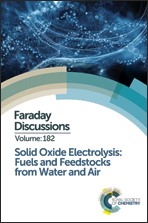A techno-economic model of a solid oxide electrolysis system
Abstract
Solid oxide cells can play a vital role in addressing energy and environmental issues. In fuel cell mode they are capable of producing electric energy at high efficiency using hydrocarbon fuels and in the electrolysis mode can produce hydrogen from steam or synthesis gas from a mixture of steam and carbon dioxide. The solid oxide electrolysis cells (SOECs) can operate at a wide range of conditions. A capable means by which to select operating conditions in the application of solid oxide electrolyzers is a necessity for successful commercial operation. Power and efficiency can be determined over a wide range of operating conditions by applying fundamental electrochemical principles to a SOEC system. Operating conditions may be selected based on power requirements or with efficiency as a priority. Operating cost for electricity which is a function of both power and efficiency can also be used to determine optimal operating conditions. Performance maps based on closed form isothermal parametric models for both hydrogen and natural gas fueled SOFC stacks have been demonstrated previously. This approach applied to a SOEC stack is shown. This model was applied to generate performance maps for a solid oxide cell stack operated in the electrolysis mode. The functional form of the model and the boundaries of the operating envelope provide useful insight into the SOEC operating characteristics and a simple means of selecting conditions for electrolysis operation.
- This article is part of the themed collection: Solid Oxide Electrolysis: Fuels and Feedstocks from Water and Air

 Please wait while we load your content...
Please wait while we load your content...